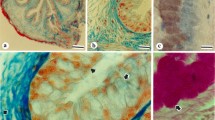Summary
Histochemical data are obtained concerning the chemical nature of olfactory mucus and pigment in the olfactory epithelium of mammals and choudrichthians. The mucus layer of the olfactory epithelium of mammals is produced by the Bowman glands. In chondrichthians it is formed by the Becher cells and probably by other mucosa cells also. The mucus is free of enzymes, but contains mucopolysaccharides and, in the case of mammals, lipids and phosphatides. From the scattered appearance of enzyme activities in the area of the olfactory mucosa a locally differing nature of the olfactory mucus is deduced. Since the liquid layer on the epithelium is the first to be contacted by the odoriferous molecules, it may play an important role in smell perception or in the primary peripheral selection of odor quality. Assuming that the adsorption of molecules on the epithelial surface represents the primary act of odor perception a mucosa layer of locally differing composition might cause a corresponding adsorption pattern and, consequently, a modulated odor perception. Further indications may be obtained by chemical analysis of olfactory mucus.
In mammals the pigment of the olfactory mucus membrane is found predominantly in the supporting cells and Bowman glands, while in fishes it is contained mainly in the supporting cells and, possibly, in the receptor cells as well. The exact chemical nature of the easily autoxidizable pigment has not yet been disclosed.
Zusammenfassung
An den Riechepithelien von Säugetieren und Knorpelfischen werden histochemische Nachweise geführt, um Angaben insbesondere zur chemischen Natur von Riechschleim und -pigment zu erhalten. Der supraepitheliale Schleimfilm ist bei den Säugetieren Produkt der Bowmanschen Drüsen. Bei den Chondrichthyern sind Becher-Zellen und wahrscheinlich such noch die übrigen Zellgattungen des Sinnesepithels als Bildungsorte anzusprechen. Der Schleim ist enzymfrei, dagegen sind Mucopolysaccharide und bei den Säugetieren zusätzlich Lipide und Phosphatide in ihm nachweisbar. Im Sinnesepithel nur verstreut auftretende Aktivitäten einiger Enzyme lassen eine örtlich wechselnde Zusammensetzung des Riechschleims annehmen. Da dieser Flüssigkeitsfilm als erster in Kontakt mit den Geruchsmolekülen tritt, ist ihm hinsichtlich der Geruchsauslösung bzw. einer Primärselektion der Sinneseindrücke in der Peripherie eine Bedeutung zuzusprechen. Die chemische Analyse des Riechschleims kann dazu weitere Hinweise liefern, zumal in der Adsorption der Geruchsmoleküle auf dem Sinnesepithel der Erstvorgang der Reizauslösung gesehen werden kann. Unter diesem Aspekt bedeutet ein örtlich unterschiedlich zusammengesetzter Schleimfilm eine Adsorptions-modulation mit entsprechenden Folgereaktionen. Das Pigment der Riechschleimhaut liegt bei den Säugetieren vornehmlich in den Stützzellen und Bowmanschen Drüsen, bei den Fischen sind die Stützzellen am ehesten als Pigmentträger anzusehen, möglicherweise beherbergen auch die Receptorzellen bei diesen Tieren Farbstoffe. Das Pigment selbst ist leicht oxidabel.
Similar content being viewed by others
Literatur
Andres, K. H.: Der Feinbau der Regio olfactoria von Makrosmatikern. Z. Zellforsch. 69, 140 (1966).
Baradi, A. F., and G. H. Bourne: (1) Theory of tastes and odors. Science 113, 660 (1951).
—, and —: (2) Localization of gustatory and olfactory enzymes in the rabbit, and the problems of taste and smell. Nature (Lond.) 168, 977 (1951).
—, and —: (3) Gustatory and olfactory epithelia. Perfum. essent. Oil Rec. 48, 434, 485 (1957).
—, and —: (4) Histochemical localization of cholinesterase in gustatory and olfactory epithelia. J. Histochem. Cytochem. 7, 2 (1959).
Bourne, G. H.: Alkaline phosphatase in taste buds and nasal mucosa. Nature (Lond.) 161, 446 (1948).
Briggs, M. H., and R. B. Duncan: Odour receptors. Nature (Lond.) 191, 1310 (1961).
Bronshtein, A. A.: (1) Observation in vivo of the motion of cilia of olfactory cells. Dokl. Akad. Nauk. SSSR 156, 715 (1964).
—: (2) Histochemistry of the olfactory organ (Pisces). Arkh. Anat. Gistol. Embriol. 48/4, 106 (1965).
Frisch, D.: Ultrastructural observations of the mouse nasal and olfactory mucosa. Anat. Rec. 148, 283 (1964).
Gerebtzoff, M. A., et E. Philippot: Lipides et pigment olfactifs. Acta oto-rhinolaryng. belg. 11, 297 (1957).
Gerhardt, H.-J.: Neueres zur Physiologie und Pathologie des Geruchssinnes. Z. ärztl. Fortbild. 56, 91 (1962).
Gesteland, R. C., J. Y. Lettvin, W. H. Pitts, and A. Rojas: Odor specifities of the frog's olfactory receptors. In: Olfaction and Taste, ed. by Y. Zotterman, p. 19–34. New York: Pergamon 1963.
Gompper, H. J.: Über das Sekret der Glandulae olfactoriae. Z. mikr.-anat. Forsch. 56, 102 (1950).
Herberhold, C.: Über den Geruchsapparat von Selachiern (In Vorbereitung).
Milas, N. A., W. M. Postman, and R. Heggie: Evidence for the presence of vitamin A and carotenoids in the olfactory area of the steer. J. Amer. them. Soc. 61, 1929 (1939).
Mohr, E.: Die Robben der europäischen Gewässer. Frankfurt: Schöps 1952.
Moulton, D. G.: Studies in olfactory acuity. 5. The comparative olfactory sensitivity of pigmented and albino rats. Anim. Behav. 8, 129 (1960).
—, and D. Tucker: Electrophysiology of the olfactory system. Ann. N. Y. Acad. Sci. 116, 380 (1964).
Onagawa, K.: On the relationship between the grade of color at the olfactory mucous membrane and the sensibility of olfactory stimulation, I–III. J. Physiol. Soc. Jap. 19, 189, 194, 198 (1937).
Ottoson, D.: Some aspects of the function of the olfactory system. Pharmacol. Rev. 15 (1963).
Philippot, E., et M. A. Gerebtzoff: Premiers résultats de l'analyse du pigment olfactif. J. Physiol. (Paris) 50, 451 (1958).
Reese, T. S., and M. W. Brightman: Electron microscopic studies on the rat olfactory bulb. Anat. Rec. 151, 492 (1965).
Spannhof, L.: Einführung in die Praxis der Histochemie. Jena: VEB Fischer 1964.
Author information
Authors and Affiliations
Rights and permissions
About this article
Cite this article
Herberhold, C. Vergleichende histochemische untersuchungen am peripheren riechorgan von Säugetieren und Fischen. Arch. Klin. Exp. Ohr.-, Nas.- U. Kehlk. Heilk. 190, 166–182 (1968). https://doi.org/10.1007/BF00426450
Received:
Issue Date:
DOI: https://doi.org/10.1007/BF00426450




